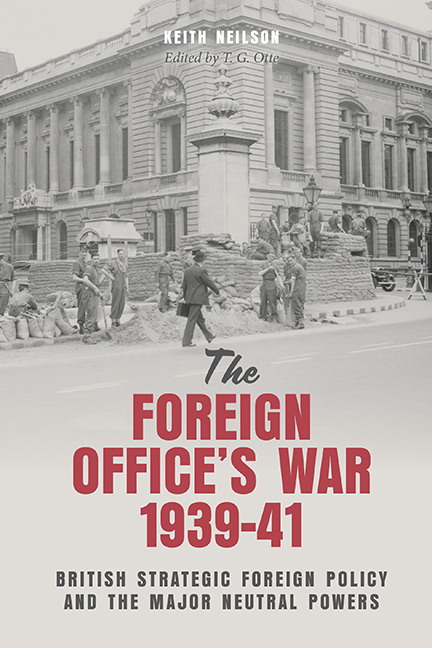Book contents
- Frontmatter
- Contents
- Preface and Acknowledgments
- List of Abbreviations
- Introduction: Keith Neilson and Modern International History
- 1 On the Eve of War: January to September 1939
- 2 The Baltic, Blockade and Soviet Russia: September 1939–June 1940
- 3 Defending the Mediterranean: Italy, Russia and the Balkans, September 1939–June 1940
- 4 Defending Britain and the Far East: The United States, Japan and Soviet Russia, September 1939–June 1940
- 5 ‘Nothing for nothing’: From the Fall of France to Operation Barbarossa: July 1940–June 1941
- Epilogue
- Appendix I Members of the American, Central, Eastern, Far Eastern, Northern and Southern Departments, 1939–41
- Appendix II Dramatis Personae
- Appendix III Keith Neilson, List of Publications
- Bibliography
- Index
1 - On the Eve of War: January to September 1939
Published online by Cambridge University Press: 16 July 2022
- Frontmatter
- Contents
- Preface and Acknowledgments
- List of Abbreviations
- Introduction: Keith Neilson and Modern International History
- 1 On the Eve of War: January to September 1939
- 2 The Baltic, Blockade and Soviet Russia: September 1939–June 1940
- 3 Defending the Mediterranean: Italy, Russia and the Balkans, September 1939–June 1940
- 4 Defending Britain and the Far East: The United States, Japan and Soviet Russia, September 1939–June 1940
- 5 ‘Nothing for nothing’: From the Fall of France to Operation Barbarossa: July 1940–June 1941
- Epilogue
- Appendix I Members of the American, Central, Eastern, Far Eastern, Northern and Southern Departments, 1939–41
- Appendix II Dramatis Personae
- Appendix III Keith Neilson, List of Publications
- Bibliography
- Index
Summary
British strategic foreign policy did not begin when war broke out on 4 September 1939. As we have seen, broad views of what would become the major neutrals had become established at the Foreign Office throughout the interwar period. However, what needs to be determined is how each of these neutrals was factored into British defence policy, particularly in the eight months before the war began, in order to appreciate what occurred when hostilities broke out.
Throughout the 1930s, Italy was important for British defence planning for a variety of reasons. First, Rome's determination to make the Mediterranean an Italian lake threatened British lines of communication to the Far East. The keys to preventing this were good diplomatic relations with Italy, and, barring the former, a strong British naval presence at Malta and in the Mediterranean generally. Second, Italy's desire to expand her colonial empire in Africa threatened Britain's position in Egypt and acted to destabilise the region. The Italian invasion of Abyssinia in 1934 in particular created difficulties for British imperial defence. Finally, beginning in 1936, the Italian participation in the Spanish Civil War not only caused strains in Anglo-Italian diplomatic relations but also caused Rome's relations with Paris to sour further. Therefore, French defence planning had to take Italy as well as Germany into consideration, particularly with respect to naval and imperial matters. For Britain, this French preoccupation meant that any attempt to improve relations with Italy (or to check her by military means) had to be done with thoughts of how this might redound on Anglo- French relations, further complicating strategic foreign policy.
The situation was clearer with respect to Japan. Since 1931, Tokyo had been militarily active on the Asian mainland, threatening the British position in the Far East. The failure of the League of Nations to contain Japan had left London in a difficult position. Opinions in Whitehall about how to deal with Japan were varied, with the Treasury favouring an Anglo-Japanese rapprochement and the Foreign Office opposing such a move. Much of this difference centred on naval matters. British defence planning in the Far East was built around the so-called ‘Singapore strategy’.
- Type
- Chapter
- Information
- The Foreign Office's War, 1939-41British Strategic Foreign Policy and the Major Neutral Powers, pp. 23 - 82Publisher: Boydell & BrewerPrint publication year: 2022



